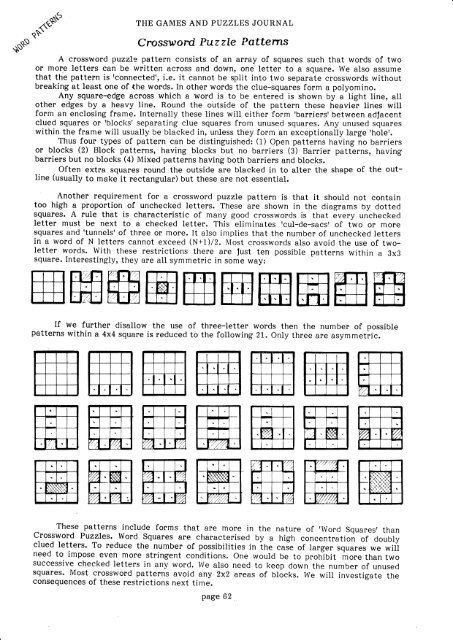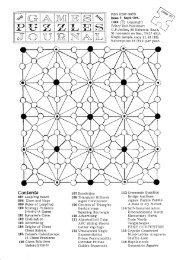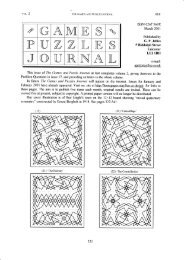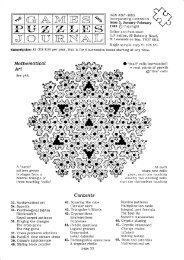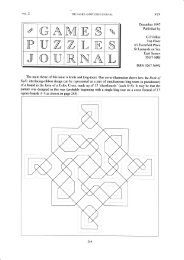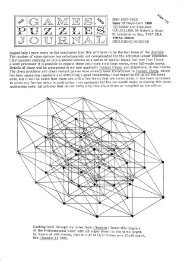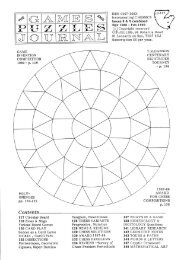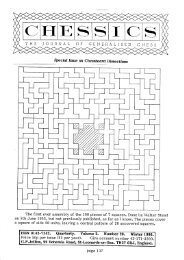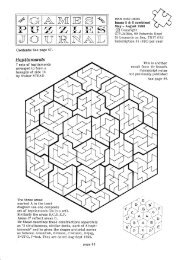The Games and Puzzles Journal, #4 - Mayhematics
The Games and Puzzles Journal, #4 - Mayhematics
The Games and Puzzles Journal, #4 - Mayhematics
Create successful ePaper yourself
Turn your PDF publications into a flip-book with our unique Google optimized e-Paper software.
$e<br />
qb' "t$t<br />
THE GAMES AND PUZZLES JOURNAL<br />
Cros"swo rd P uz zle F otterTs<br />
A crosswotd puzzle pattern consists of an array of squares such that words of two<br />
or more letters can be written across <strong>and</strong> down, one letter to a square. We also assume<br />
that the pattern is connected', i.e. it cannot be split into two separate crosswords without<br />
breaking at least one of the words. In other words the clue-squares form a polyomino.<br />
Any square-edge across which a word is to be entered is shown by a light line, all<br />
other edges by a heavy line. Round the o'utside of the pattern these heavier lines will<br />
form an enclosing frame. Internally these lines will either form 'barrierstbetween adJacent<br />
clued squares or fblockst separating clue squares from unused squares. Any unused squares<br />
within the frame will usually be blacked in, unless they form an exceptionally large 'holer.<br />
Thus four types of pattern can be distinguished: (1) Open patterns having no barriers<br />
or blocks (2) Block patterns, having blocks but no barriers (3) Barrier pattlrns, having<br />
baniers but no blocks (4) Mixed patterns having both barriers <strong>and</strong> blocks.<br />
Often extra squares round the outside are blacked in to alter the shape of the outline<br />
(usually to make it rectangular) but these are not essential.<br />
Another requirement for a crossword puzzle pattern is that it should not contain<br />
too high a proportion of unchecked letters. <strong>The</strong>se are shown in the diagrams by dotted<br />
squares. A rule that is characteristic of many good crosswords is that every unchecked<br />
letter must be next to a checked letter. This eliminates rcul-de-sacst of two or more<br />
sguares <strong>and</strong> rtunnelsr of three or more. It also implies that the number of unchecked letters<br />
in a word of N letters cannot exceed (U+117r. Most crosswords also avoid the use of twoletter<br />
words. With these restrictions there are Just ten possible patterns within a 3x3<br />
square. Interestinglv, they are all symmetric in some way:<br />
ffiffiffiffiffiffiffiffiwffi<br />
If we further disallow the use of three-letter words then the<br />
patterns within a 4x4 square is reduced to the following 21. only three<br />
number of possible<br />
are asym metric.<br />
ffi<br />
ffi<br />
ffi<br />
ffiffiffiffiffiffi<br />
ffiffiffiffiffiffi<br />
MffiffiffiffiM<br />
_ <strong>The</strong>se patterns include forms that are more in the nature of 'Word Squaresr than<br />
Crossword <strong>Puzzles</strong>. Word Squares are characterised by a high concentration of doubly<br />
clued letters. To reduce the number of possibilities in ine caJe of larger squares we will<br />
need to impose even more stringent conditions. One would be to proh-ibit rnore than two<br />
successive checked letters in any word. We also need to keep down the number of unused<br />
squares. Most crossword patterns avoid any 2x2 areas of blocks. We will investigate the<br />
consequences of these restrictions next time.<br />
page 62


